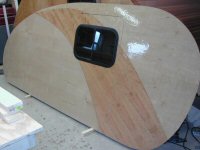Louella, what about some clear plastic tablecloth material from the fabric places over there ?
It's similar to the product used in the Rr windows on convertible ragtops.
Yep, still off topic, sorry, can Admin split this off to a new thread ?
Now, back to our regular scheduled program,
Applying canvas without wrinkles ....
Applying canvas without wrinkles ....
Moderator: eaglesdare
25 posts
• Page 2 of 2 • 1, 2
Re: Applying canvas without wrinkles ....
Lance & Anne
Completing a Project
TD Stubby
Completing a Project
TD Stubby
-

Lancie49 - Teardrop Advisor
- Posts: 86
- Joined: Sat Mar 03, 2012 8:53 am
- Location: Melbourne, Australia
Re: Applying canvas without wrinkles ....
GPW wrote:W2 , I also considered a sewn “sock” for over the foam ... You’d have to be Exact and still maybe just leave one end loose to allow for material stretch (unless you were really GOOD !!! ) ... like a big toaster cozy ... sorta’ ...Fitted properly , it would give the advantage of perfect seams , and would be very attractive/ pleasing to the eye ... appearing somewhere between tent and trailer ... all in the details ... No reason a foamie can’t look Cool ... I’m investigating some chrome trim from the auto parts store ... comes on a roll ,pretty inexpensive , just a little looks “trick” ... could protect the sides from careless car doors too ... “decorations”

More on this ... for a really lightweight Foamie , think about a tent attached to the foam , using tent-like window openings and screens, flaps etc. ... like Velcro on windows , waterproof flap above sewn into the “sock” ... things like that ... Bare minimum ... could even have a snap on , or Velcro interior sock ... with padding in all the right places, little pockets to hold your stuff ... you could even take it in and out later to wash it ...The foam merely giving the ”tent” it’s shape and providing insulation ... Simple but challenging ....
What about making the tent shape you want then lining it with Foam
 Paint it and it would be a perfect fit with straight seems. Or does the fabric stretch change as you paint it?
Paint it and it would be a perfect fit with straight seems. Or does the fabric stretch change as you paint it?- loaderman
- The 300 Club
- Posts: 306
- Joined: Fri Jan 27, 2012 12:03 am



 If you dampen the canvas slightly , it’ll stretch/smooth out better ...
If you dampen the canvas slightly , it’ll stretch/smooth out better ...
